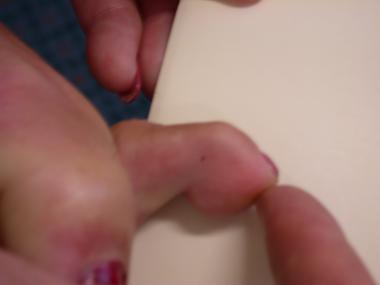

A mallet toe is a fixed or flexible deformity of the distal interphalangeal (DIP) joint of the toe (see the image below). It is characterized by neutral positioning of the metatarsophalangeal (MTP) and proximal interphalangeal (PIP) joints in the face of a flexed DIP joint, in contrast to the extended or neutral position of the MTP joint and flexed position of the PIP joint characterized by the more common hammertoe deformity. Because the DIP joint in patients with hammertoe deformity can present with extension, flexion, or neutral positioning, the clinician should be familiar with both conditions.[1]
 Classic mallet toe. Note flexion when toe is dorsiflexed.
Classic mallet toe. Note flexion when toe is dorsiflexed.
Pain, callosity, or both may be the presenting complaints when the DIP joint of the toe has abnormal flexion, either fixed or flexible.
Treatment of mallet toe deformity is relatively straightforward (see Treatment). Some controversy exists over the need for flexor tenotomy when DIP joint fusion is attempted and the question of whether this leads to a higher incidence of hyperextension deformity and PIP joint flexion at the adjacent PIP joint.
For information on related topics, see Claw Toe and Hammertoe Deformity.
NextThe DIP joint is a hinge joint with collateral and accessory collateral ligaments and a plantar plate. The flexor sheath extends to the DIP joint.[2, 3]
The principal pathophysiology is flexion of the DIP joint with pressure on the tip of the toe, often with associated attenuation of the extensor tendon (see the image below). This may lead to callosities or nail deformity on the tip of the toe. The deformity may be flexible in cases where the principal problem is an overtight flexor digitorum longus. However, it is not associated with contracture of the joint capsule or with fixed deformities in cases where the plantar joint structures are contracted or alteration of the joint surfaces restricting joint range of motion has occurred.[4, 5, 6, 7]
 Classic mallet toe. Note flexion when toe is dorsiflexed.
Classic mallet toe. Note flexion when toe is dorsiflexed.
Mallet toe deformity of a long toe is usually idiopathic. Inappropriate shoe wear, iatrogenic causes (eg, previous PIP joint fusion), congenital abnormalities, trauma, neuromuscular disorders, and pes cavus can all lead to the deformity.[8]
In the United States, mallet toe deformity is much less common than hammertoe deformity, with a 1:9 ratio. It occurs most often in the longest toe (75%) but can also occur in the second, third, or fourth toe. In as many as 12% of cases, associated lateral or medial deviation may be present.
The international incidence of mallet toe is unknown; however, population‐based studies in Australia and Sweden reported that surgical management of these deformities accounts for between 28% and 46% of all forefoot surgery performed in those countries.[9, 10]
Most series found excellent results in 85-97% of cases.[11] In some series, tenotomy seemed to increase satisfaction rates. Bony union of the DIP joint where resection was carried out had higher satisfaction rates than fibrous union did.
Clinical Presentation
Copyright © www.orthopaedics.win Bone Health All Rights Reserved